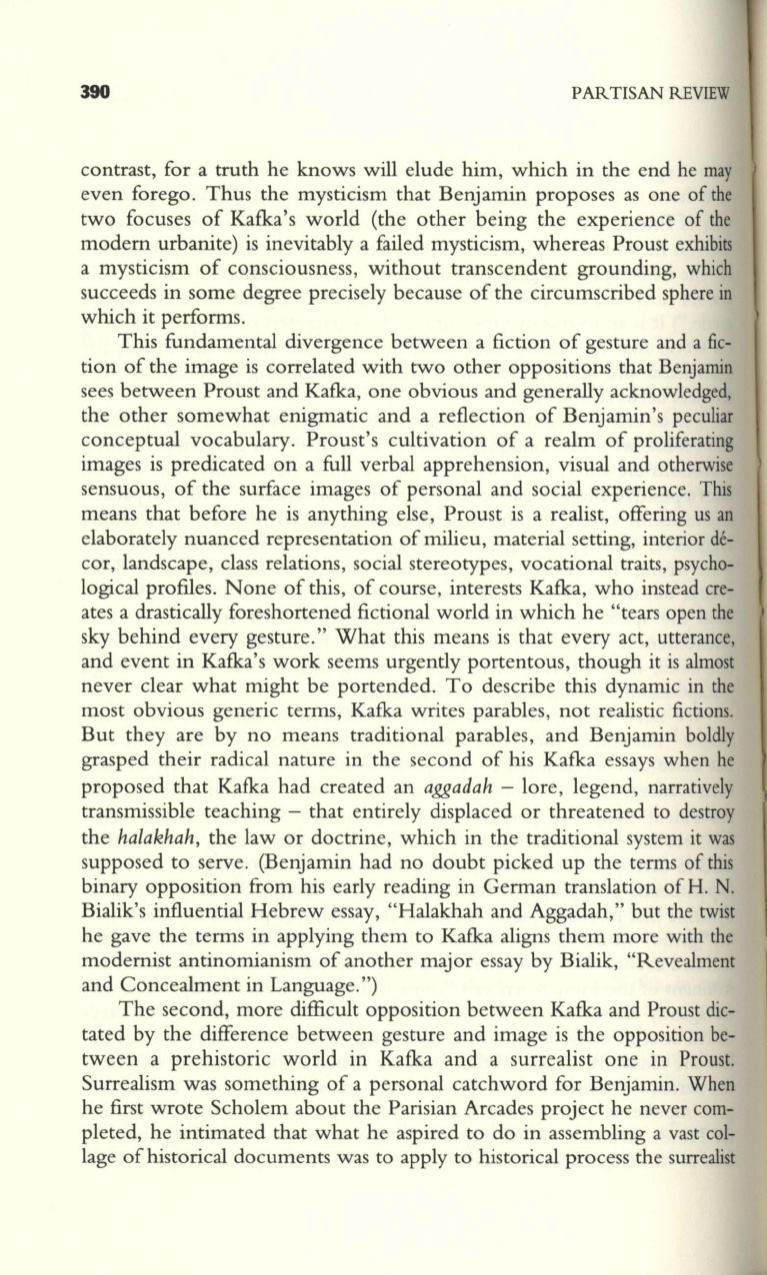
390
PARTISAN REVIEW
contrast, for a truth he knows will elude him, which in the end he may
even forego. Thus the mysticism that Benjamin proposes as one of the
two focuses of Kafka's world (the other being the experience of the
modem urbanite) is inevitably a failed mysticism, whereas Proust exhibits
a mysticism of consciousness, without transcendent grounding, which
succeeds in some degree precisely because of the circumscribed sphere
in
which it performs.
This fundamental divergence between a fiction of gesture and a fic–
tion of the image is correlated with two other oppositions that Benjamin
sees between Proust and Kafka, one obvious and generally acknowledged,
the other somewhat enigmatic and a reflection of Benjamin's peculiar
conceptual vocabulary. Proust's cultivation of a realm of proliferating
images is predicated on a full verbal apprehension, visual and otherwise
sensuous, of the surface images of personal and social experience. This
means that before he is anything else, Proust is a realist, offering us an
elaborately nuanced representation of milieu, material setting, interior de–
cor, landscape, class relations, social stereotypes, vocational traits, psycho–
logical profiles. None of this, of course, interests Kafka, who instead cre–
ates a drastically foreshortened fictional world in which he "tears open the
sky behind every gesture." What this means is that every act, utterance,
and event in Kafka's work seems urgently portentous, though it is almost
never clear what might be portended. To describe this dynamic in the
most obvious generic terms, Kafka writes parables, not realistic fictions.
But they are by no means traditional parables, and Benjamin boldly
grasped their radical nature in the second of his Kafka essays when he
proposed that Kafka had created an
aggadah
-
lore, legend, narratively
transmissible teaching - that entirely displaced or threatened to destroy
the
halakhah,
the law or doctrine, which in the traditional system it was
supposed to serve. (Benjamin had no doubt picked up the terms of this
binary opposition from his early reading in German translation of H.
N.
Bialik's influential Hebrew essay, "Halakhah and Aggadah," but the twist
he gave the terms in applying them to Kafka aligns them more with the
modernist antinomianism of another major essay by Bialik, "Revealment
and Concealment in Language.")
The second, more difficult opposition between Kafka and Proust dic–
tated by the difference between gesture and image is the opposition be–
tween a prehistoric world in Kafka and a surrealist one in Proust.
Surrealism was something of a personal catchword for Benjamin. When
he first wrote Scholem about the Parisian Arcades project he never com–
pleted, he intimated that what he aspired to do in assembling a vast col–
lage of historical documents was to apply to historical process the surrealist


